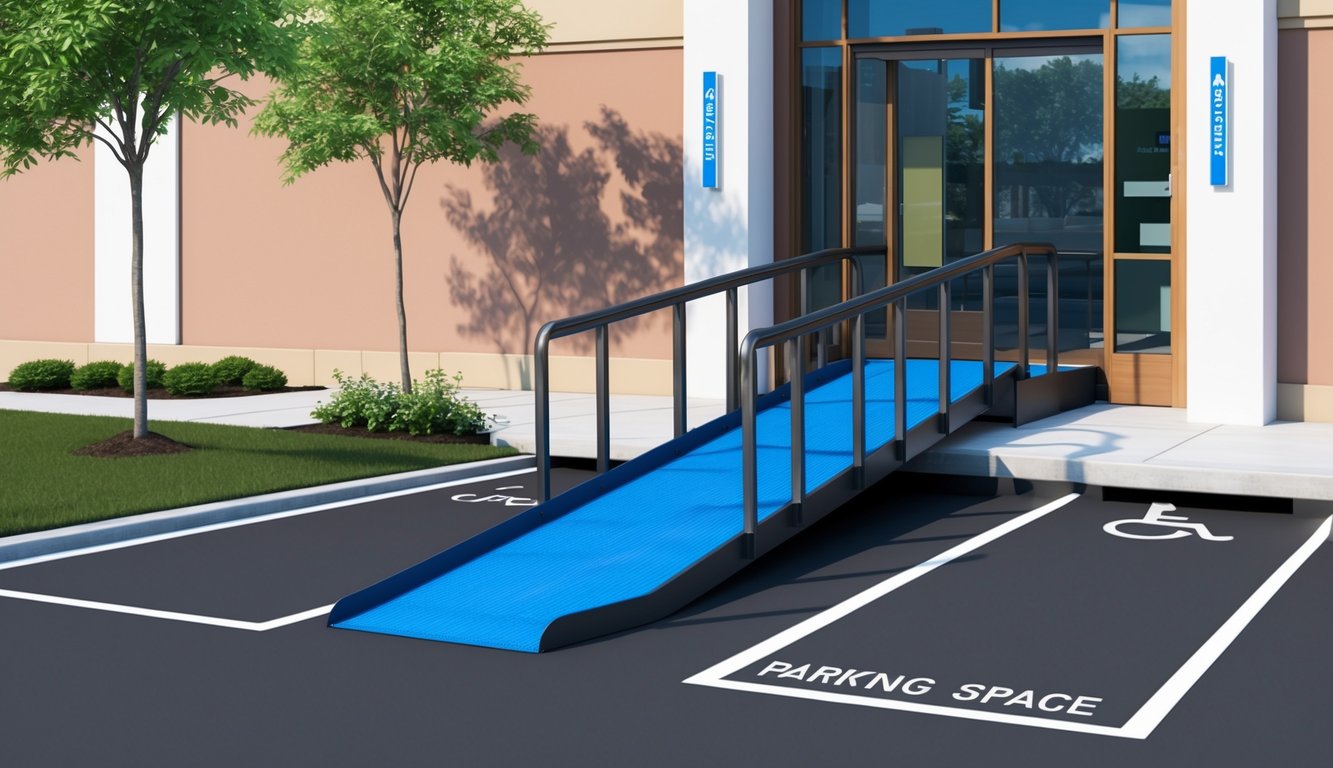ADA Compliance Overview
ADA compliance is essential for ensuring equal access to services and facilities for individuals with disabilities.
This section explores the historical context of the Americans with Disabilities Act, the key components that define its framework, and the significance of accessibility in various sectors, including insurance.
Historical Context and Civil Rights
The Americans with Disabilities Act (ADA) is a pivotal piece of civil rights legislation.
It emerged from a long history of advocacy by disability rights activists who sought equality and an end to discrimination based on disabilities.
Prior to the ADA, individuals often faced significant barriers in employment, public services, and public accommodations.
The act builds on earlier civil rights laws, offering legal protection against discrimination for people with disabilities.
This historical context underscores the impact of the ADA on promoting inclusive practices across different sectors, including healthcare and insurance, where accessibility is crucial.
Key Components of the ADA
The ADA outlines several key components aimed at preventing discrimination against individuals with disabilities.
It is divided into five titles, addressing areas such as employment, public services, public accommodations, telecommunications, and other miscellaneous provisions.
Title I covers employment, requiring employers to provide reasonable accommodations. Title II addresses public services, mandating accessibility in state and local government programs. Title III focuses on public accommodations, ensuring facilities such as insurance offices meet accessibility standards.
The ADA Standards set specific guidelines on how to make facilities accessible, ensuring conformity across sectors.
The Importance of Accessibility
Accessibility is not merely a legal obligation; it fosters inclusivity and enhances customer experience.
For the insurance industry, making services accessible can improve client relationships and expand market reach.
When your office is compliant with ADA regulations, you demonstrate a commitment to equality.
This, in turn, helps build trust with clients who may face barriers otherwise.
Not only does compliance reduce the risk of litigation, but it also positions your business as a leader in promoting disability rights.
Ensuring accessible communication and services ultimately benefits everyone involved.
ADA Standards and Regulations

Understanding ADA standards and regulations is essential for ensuring compliance in various environments, especially in the insurance industry where accessibility impacts policyholders and claims processes.
This section outlines the critical components of the ADA regulations that govern facilities and services.
2010 ADA Standards for Accessible Design
The 2010 ADA Standards for Accessible Design provide detailed guidelines for making facilities accessible to individuals with disabilities.
These standards apply to new construction and alterations of existing buildings.
Key provisions include requirements for accessible routes, entrance access, and restroom facilities.
Your facility must be equipped with features such as accessible parking spaces, ramps, and elevators to meet these guidelines.
Refer to the ADA Standards for Accessible Design for specific measurements and criteria.
Accessibility Requirements for Public Accommodations
Accessibility requirements for public accommodations under Title III of the ADA ensure that businesses provide equal access to services for all individuals.
This includes retail stores, hotels, restaurants, and professional offices.
Your facility should have accessible entrances, service areas, and clear signage.
Public accommodations must remove barriers that may prevent access.
This may involve modifying existing structures or policies to comply with ADA requirements.
For comprehensive guidance on your obligations, consult the Department of Justice.
ADA Compliance for New Construction and Alterations
When undertaking new construction or significant alterations, you must adhere to the ADA requirements.
This includes compliance with the 2010 ADA Standards, ensuring that newly created spaces are fully accessible.
Existing facilities undergoing alterations must also accommodate accessibility through structural changes.
This might involve widening doorways, installing lifts, or adding grab bars.
Proper planning in these stages can mitigate liability and enhance safety for all users.
ADA Title I, II, and III Regulations
ADA Title I, II, and III cover various aspects of accessibility including employment, public services, and public accommodations.
- Title I pertains to employment regulations, ensuring that individuals with disabilities have equal job opportunities.
- Title II focuses on public services, ensuring state and local governments provide accessible services.
- Title III mandates public accommodations to be accessible to individuals with disabilities.
Understanding these titles is crucial for compliance in the insurance sector, as they influence coverage for accessibility-related claims.
For detailed information regarding these regulations, you can visit the ADA National Network.
Rights and Obligations

Understanding the rights of individuals with disabilities and the obligations of various entities under the ADA is crucial.
This section outlines the essential rights granted to individuals, the responsibilities of employers and service providers, and the processes available for addressing grievances.
Rights of Individuals with Disabilities
As an individual with a disability, you possess numerous legal rights under the ADA.
These rights encompass access to public accommodations, employment opportunities, and effective communication in various settings.
For instance, you should receive reasonable accommodations from your employer to perform your job effectively.
This may include modifications to the workspace or adjustments in work schedules.
Additionally, you have the right to equal opportunities in public services, which includes accessibility in places like restaurants, hotels, and transport systems.
Your legal protections extend to both state and local government entities.
Responsibilities of Entities Under ADA
Entities covered by the ADA, such as employers and service providers, are expected to meet several responsibilities.
Employers with 15 or more employees must ensure that their hiring practices do not discriminate against individuals with disabilities.
This includes providing reasonable accommodations during the recruitment process and in the workplace.
Additionally, public accommodations must comply with accessibility standards, ensuring that you can access their services and facilities.
This involves removing physical barriers and offering alternative formats for communication when necessary.
Clear guidelines exist for what constitutes reasonable accommodation, and entities must remain informed about these requirements.
Non-Discrimination and Equal Opportunity
The ADA mandates non-discrimination and equal opportunity for individuals with disabilities.
You cannot be denied services, jobs, or benefits based on your disability status.
This principle supports your right to participate fully in society, ensuring that you have the same opportunities as individuals without disabilities.
In the insurance industry, for example, it is unlawful for insurers to discriminate against you when providing policies or benefits due to a disability.
Policies must reflect equal treatment, promoting fair access to coverage and benefits.
Entities are expected to implement strategies that champion diversity and inclusion in their practices.
Complaint and Mediation Process
If you believe your rights under the ADA have been violated, several options are available for resolution.
You can initiate a complaint with the Equal Employment Opportunity Commission (EEOC) or your local ADA center.
This process typically requires filing a detailed account of the alleged discrimination, which initiates an investigation.
The ADA also encourages mediation as a means to resolve disputes amicably.
This voluntary process can help you and the entity reach a mutually agreeable solution without resorting to lengthy legal battles.
It’s essential to document all interactions and communications regarding your complaint to support your case.
Architectural and Transportation Barriers

Accessibility in architecture and transportation directly influences your ability to navigate public spaces.
Understanding the specific barriers that exist helps you advocate for necessary changes.
Accessible Design in Architecture
When designing buildings, you must prioritize accessible features to meet accessibility standards.
Essential elements include wide doors, ramps, and clear visual signage.
Accessible routes should connect all entries and exits, ensuring everyone can move through the space safely.
Important considerations include:
- Accessible Parking: Designated spots for individuals with disabilities should be close to building entrances.
- Door Specifications: Doors should require minimal force to open, with automatic doors being a preferred option.
Following these guidelines helps create places of public accommodation that are inclusive for all.
Transportation and Accessibility
Your access to transportation facilities impacts daily mobility.
Compliance with the Americans with Disabilities Act (ADA) ensures that public transit facilities accommodate individuals with disabilities.
Key factors include:
- Public Transit Facilities: These should offer accessible routes and information systems, making travel easier.
- Transportation Services: Services must be available that cater to the needs of those with limited mobility or other impairments.
Regular updates to accessibility standards by the U.S. Access Board ensure that transportation systems evolve alongside growing needs.
Barrier Removal and Program Accessibility
Removing architectural barriers is crucial for improving access in state and local government facilities.
Regular assessments identify areas needing alteration or enhancement.
Important steps involve:
- Implementing updated accessibility guidelines.
- Offering training for staff on how to assist individuals with disabilities effectively.
You can leverage grant programs aimed at facilitating barrier removal in facilities to ensure compliance and enhance usability.
By addressing these challenges, you contribute to a more inclusive environment for all individuals.
Digital Accessibility and Best Practices

Ensuring digital accessibility is essential for all businesses, including those in the insurance industry.
You must understand how to achieve compliance and create an inclusive online environment for all users.
Web Accessibility and ADA Compliance
ADA compliance for websites involves making sure that your digital content is accessible to individuals with disabilities.
This includes adhering to the Web Content Accessibility Guidelines (WCAG), which set the standard for web accessibility.
By following these guidelines, you can reduce barriers and provide equal access to your services.
Your website must be navigable by keyboard, with clear text descriptions for images.
Incorporating these elements not only helps users with visual impairments but also improves the experience for everyone.
Regular audits can identify compliance gaps, ensuring you meet legal obligations while enhancing user satisfaction.
Assistive Technologies and Online Barriers
Assistive technologies play a vital role in digital accessibility.
Tools like screen readers help visually impaired users navigate websites effectively.
As you design your online platforms, it’s essential to recognize online barriers that may prevent these tools from functioning correctly.
Common accessibility issues include poor alt text for images and videos that lack captions.
By addressing these concerns, you promote a more inclusive experience.
Implementing features that work seamlessly with assistive technologies can significantly improve how users interact with your insurance services.
Implementing WCAG and Accessibility Guidelines
To effectively implement WCAG and other accessibility guidelines, consider starting with the basics.
Create a checklist that includes key elements such as proper heading structures, sufficient color contrast, and keyboard navigation.
Establishing accessibility goals within your organization can help foster a culture of inclusivity.
Training employees on best practices ensures that all aspects of your digital presence adhere to these guidelines.
Regular updates and feedback loops can help maintain compliance as technology evolves.
Frequently Asked Questions

Understanding ADA compliance involves specific standards and guidelines related to disability access and rights.
This section addresses common inquiries regarding compliance, including definitions, requirements, and best practices.
What does it mean to be ADA compliant?
Being ADA compliant means adhering to the standards set by the Americans with Disabilities Act, ensuring that individuals with disabilities have equal access to facilities, services, and employment opportunities.
Compliance is essential for avoiding discrimination and fostering an inclusive environment.
What are the ADA Accessibility Guidelines for buildings and facilities?
The ADA Accessibility Guidelines provide a framework for designing accessible public spaces.
These guidelines cover various aspects such as building entrances, restrooms, and signage to ensure they accommodate individuals with different disabilities.
What disabilities are covered under the ADA?
The ADA covers a wide range of disabilities, including physical, mental, and sensory impairments.
Examples include mobility limitations, visual impairments, hearing disabilities, and mental health conditions, ensuring protection against discrimination in various settings.
What is considered a violation of ADA?
An ADA violation occurs when individuals with disabilities are denied access to services, facilities, or employment based on their disability.
This can include inaccessible buildings, inadequate communication support, or failure to provide reasonable accommodations.
What are the ADA compliance requirements for businesses?
Businesses must remove barriers to access and ensure their services are available to individuals with disabilities.
This may involve modifying facilities, providing auxiliary aids, and training staff on disability awareness and rights.
How do I ensure my website is ADA compliant?
To ensure your website is ADA compliant, you should implement accessibility features like alternative text for images, keyboard navigation, and readable fonts.
You should also regularly test your website with assistive technologies.
This can help you identify and address any accessibility issues.






